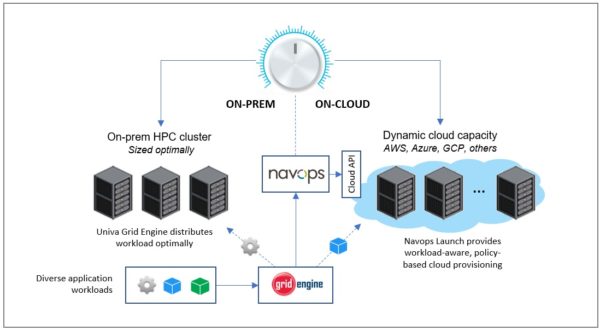Univa’s Robert Lalonde, Vice President and General Manager, Cloud, highlights the reason behind the recent cloud adoption boom among the HPC community, and the benefits of hybrid HPC cloud.

Robert Lalonde, Vice President and General Manager, Univa
Over the past two years, we’ve seen a dramatic acceleration in cloud adoption for HPC. This is validated by our 2018 Univa customer survey where 61 percent of respondents indicated that they are already using or considering public clouds.
Intuitively cloud computing makes sense — it enables organizations to rent rather than buy expensive HPC hardware, deploy solutions faster, reduce capital investments, and focus on core competencies. While the benefits are real, there are risks as well. In this short article, we explain how planning for flexibility can help de-risk your hybrid-cloud business case.
On Jumping into the Cloud
While it may work for some, overly aggressive adoption of cloud services carries its own risks. HPC software-as-a-service (SaaS) offerings and proprietary cloud services deserve special scrutiny. Despite the convenience, we can wake up one day to find that we’ve replaced our capital-intensive data center with even more costly infrastructure while becoming dependent on a single provider. We’ve seen studies and internal reports from end-users that have sized the cost of HPC cloud verses on-premise resources as low as three times and as high as nine times increase in cost. Mistakes of this kind can be difficult to correct.
The process of shifting application workloads between on-prem and variable-cost cloud infrastructure needs to be seamless.
Striking the Right Balance
For cloud projects, a better strategy is usually evolution not revolution. A useful mental model is to view a hybrid-cloud as a giant rheostat or balance control. Ideally, organizations should be able to dial up or down relative investments in local vs. cloud infrastructure. Choices can range from full “on-prem” to “all cloud all the time” to more balanced percentages in between.

The attraction of this approach is that your business case doesn’t need to be perfect out of the gate. The virtual dial can be adjusted as you gain experience, and it provides you with the flexibility to accommodate future workloads. It’s also convenient if your cost projections or operating assumptions turn out to be wrong – you can simply re-adjust the dial.
The keys to making this dial metaphor work are understanding the efficiency of HPC cloud resource spending and intelligent automation. Knowing spending patterns vs. budget provides insights into how to better use the cloud, and how to improve usage by modifying resource requests, workload placement, and data staging. Second, without automation it can take significant effort every time you change the dial, suggesting there is too much friction in your provisioning process.
The process of shifting application workloads between on-prem and variable-cost cloud infrastructure needs to be seamless. Hybrid cloud management software is critical to enabling you to turn the dial up or down freely and stay nimble.
Strategies to De-risk Your Hybrid Cloud Business Case
- Make sure you have a handle on your existing environment. This goes beyond just infrastructure and software and extends to productivity considerations such as usage by application, user wait times, utilization, and time and cost to deploy applications. Workload managers provide metrics about how resources are consumed by application, project, and department so you can better understand the costs of running workload on-premise. This data becomes the basis for measuring efficiency in the cloud.
- Look for tools that see the hybrid cloud as a single environment.
Ideally, cloud resources should be managed as an extension to the on-premise environment. Look for application-aware, multi-cloud tools that enable you to place workload, manage data, and monitor cloud spending across a hybrid infrastructure through a “single pane of glass.” With a consolidated view of cost and utilization across clouds you can make better decisions around what workload to run where.
- Plan for continuous optimization. With the right tools, hybrid environments provide rich opportunities for optimization. As you gain experience, you can shift application workloads to where they deliver the best service levels for the lowest cost, right-size cloud resource requirements to precisely match application demand, and keep on-premise resources busy while you carefully manage costs in the cloud. Start by setting realistic and achievable goals and aim for continuous efficiency gains year-over-year.
For organizations deploying HPC cloud environments, Navops Launch controls how applications are placed in the cloud, maps application resource requirements to cloud resources and helps organizations visualize cloud spending for maximum efficiency. By using Univa Grid Engine with Navops Launch, organizations can seamlessly extend on-premise clusters to their choice of clouds with minimal impact to existing applications, containers, and services and use policy-based bursting to pay for only the infrastructure they use.
At Univa we’ve helped dozens of clients extend their existing on-premise HPC environments to the cloud and realize a more flexible, scalable and efficient hybrid cloud environment. We’d love to hear about your HPC hybrid cloud challenges.
Robert Lalonde is Vice President and General Manager, Cloud, at Univa. Follow Lalonde @NavopsRob.



